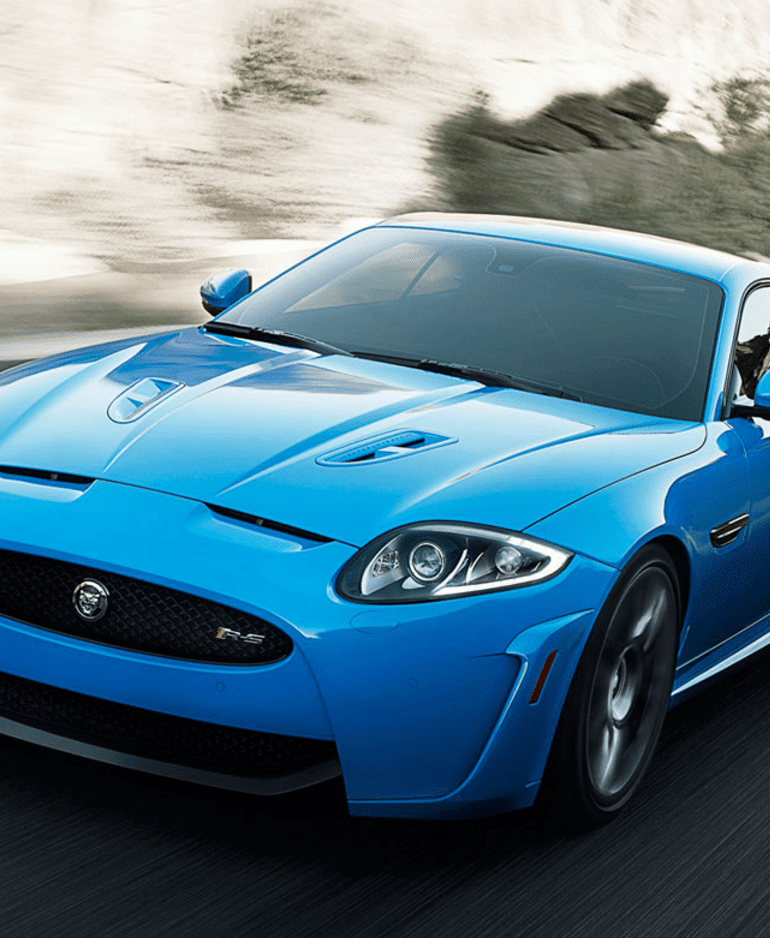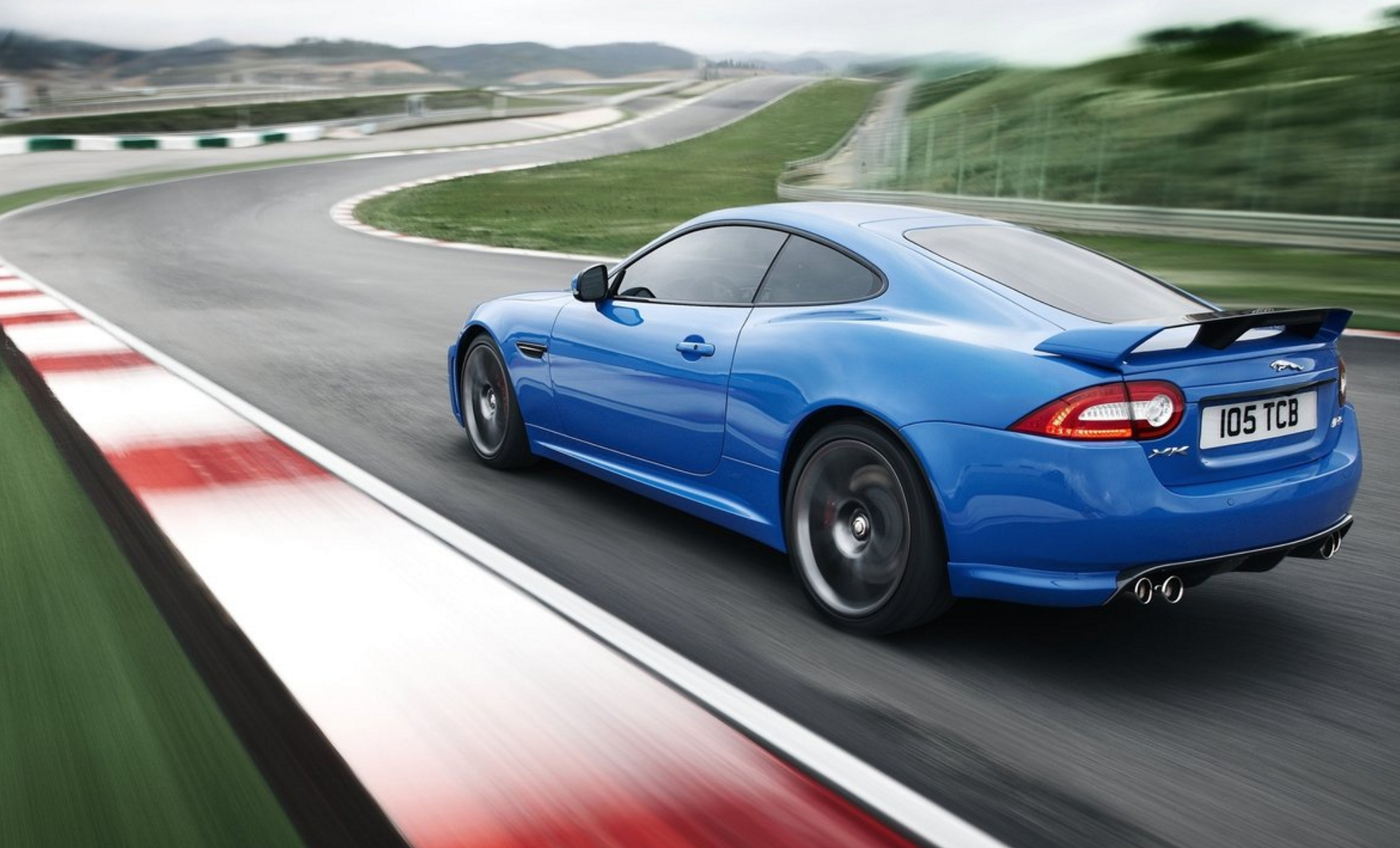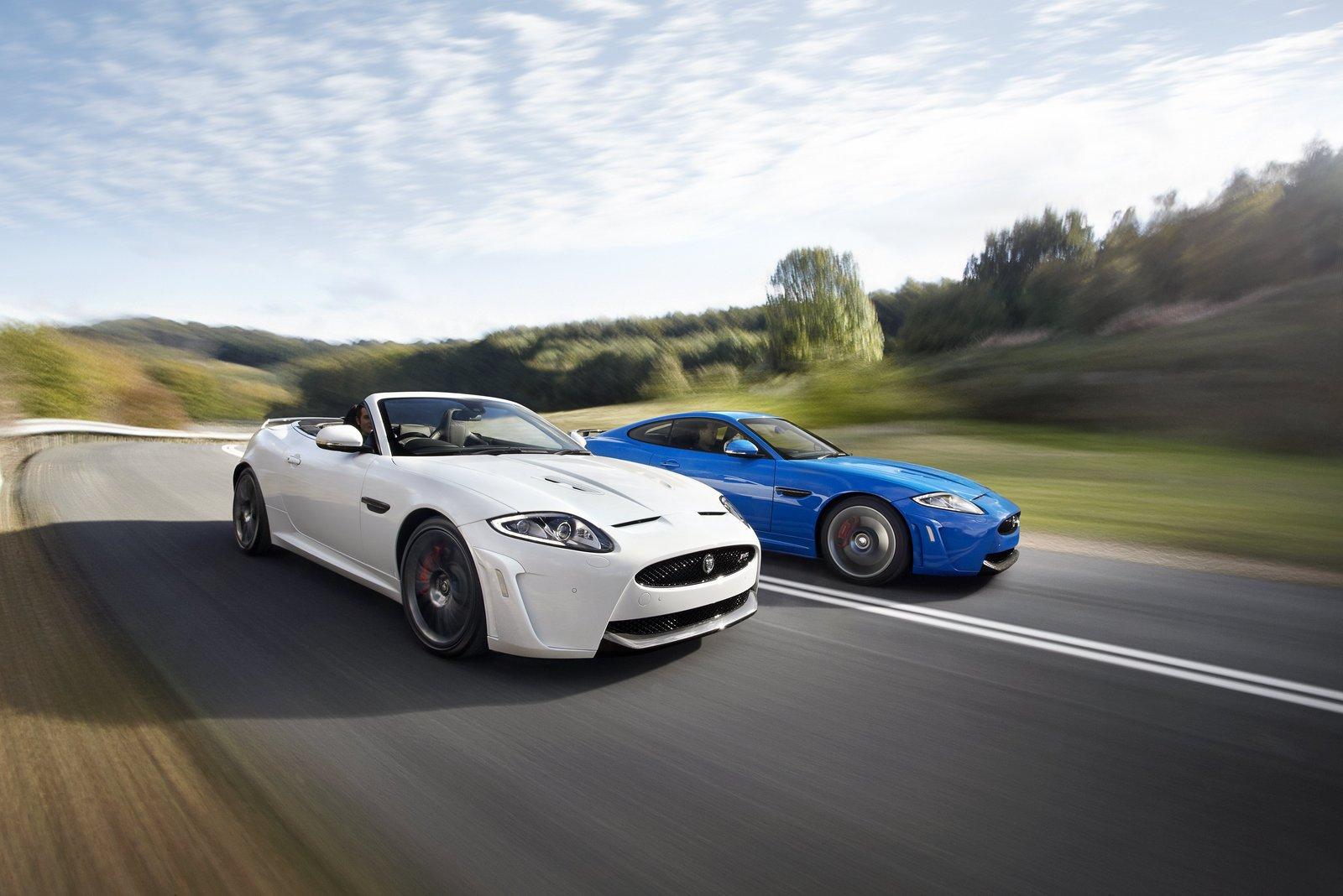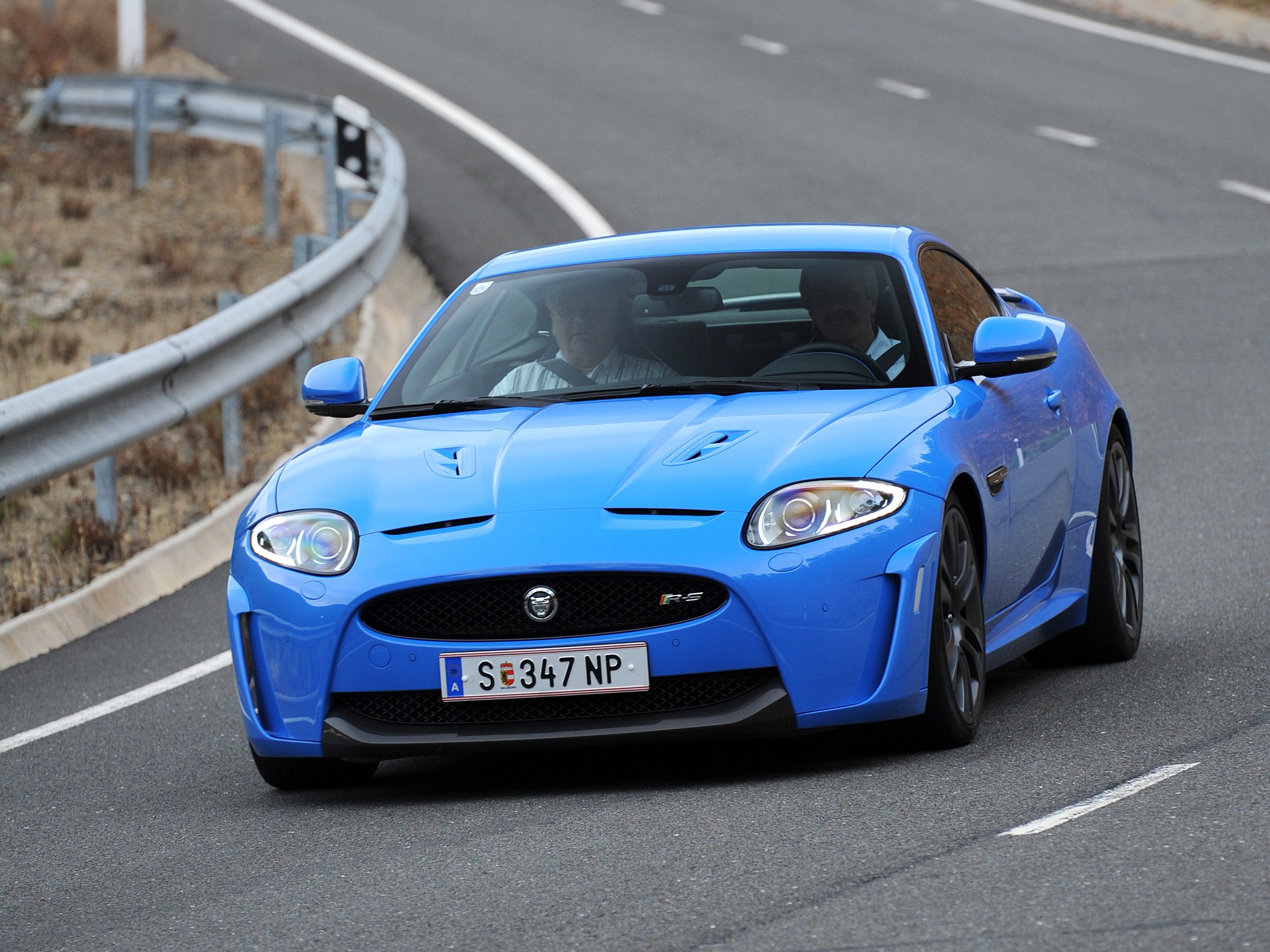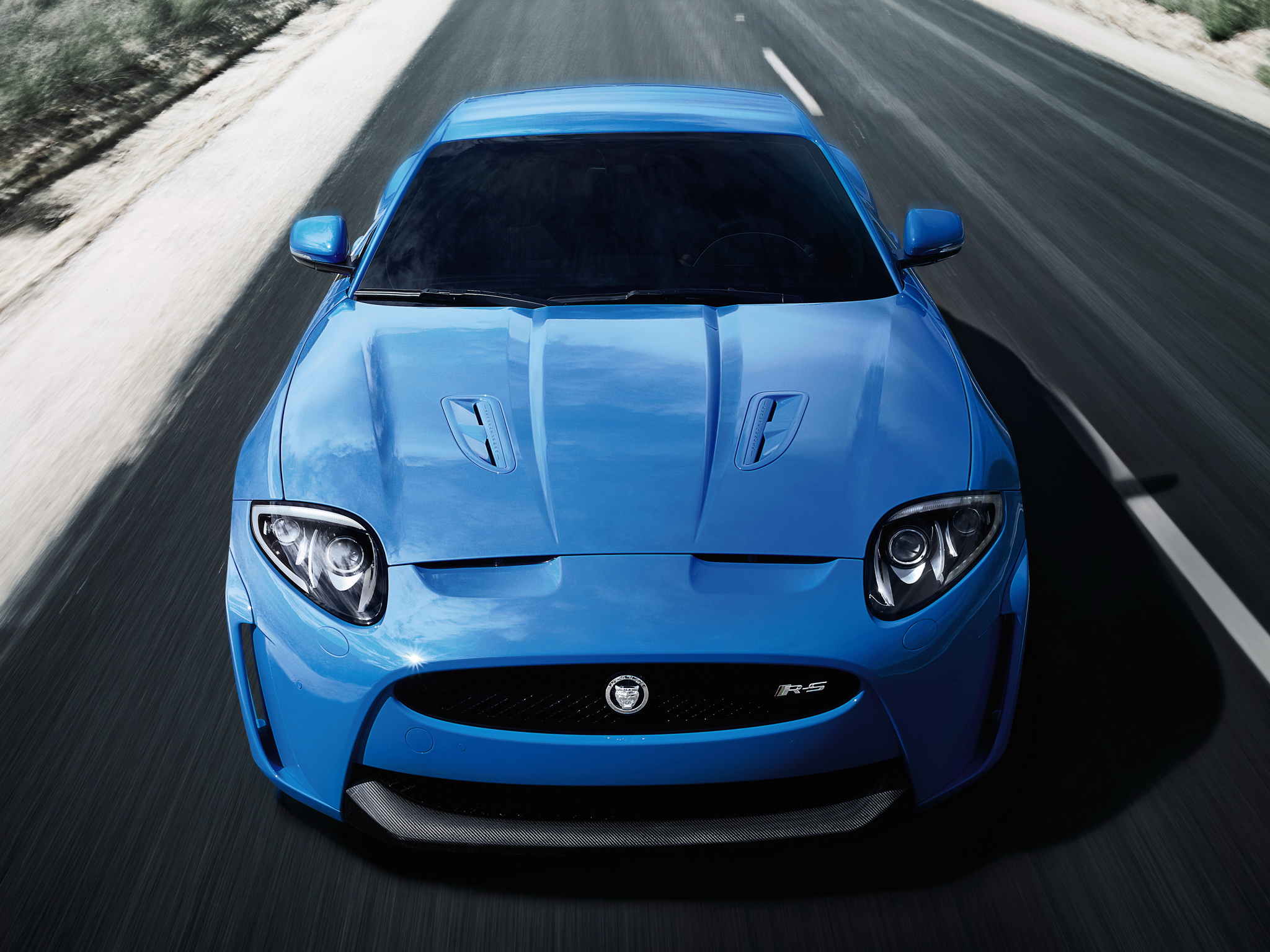2011 Jaguar XKR-S
Making its debut at the Geneva Motor Show 2011, the XKR-S is the most extreme expression yet of Jaguar’s passion for building beautiful, fast cars. For the first time with a series production car, Jaguar gains entry to the exclusive ‘300kph club’ thanks to the effortless performance of the supercharged 5.0-litre AJ-V8 engine. A revised fuelling map means the direct-injection powerplant now produces 550PS and 680Nm of torque. Extensive recalibration has ensured that power delivery and performance are seamless, contributing to a 0-60mph time of 4.2 seconds. The Performance active exhaust encourages and rewards the enthusiastic driver with dramatic, motorsport-inspired aural feedback.
See full Jaguar XKR-S Gallery. Watch amazing Jaguar videos.
The XKR-S is not merely the quickest Jaguar ever but also the most agile, responsive and driver-focused. The pinnacle of the XK range builds on feedback gathered from the supercharged XKR and has been developed to extend the performance parameters of the car. This new harder-edged character allows the enthusiastic driver to explore the outer limits of the car’s dynamics without losing the refinement and usability for which Jaguar is famous. The structural integrity of the lightweight aluminium platform allowed the suspension to be reworked with bespoke components for increased stiffness without a commensurate loss in either refinement or Jaguar’s legendary ride comfort. A reworked aluminium front suspension knuckle and revised rear geometry are allied to stiffer springs and dampers, lightweight forged alloy wheels and recalibrated steering effort to minimise any response delays and produce a more connected and agile driving experience.
The performance of the XKR-S is reflected in both its interior and exterior styling, which feature exclusive new paint colours that reflect Jaguar’s racing heritage. As with competition Jaguars of the past, the exterior of the XKR-S adheres to the principle of form following function. In addition to the styling changes and in order for it to achieve 300kph, the XKR-S was the subject of extensive Computational Fluid Dynamics development work. The resulting changes reduced front and rear lift by more than a quarter and optimised lateral aerodynamic stability.
The performance intent of the XKR-S is clear from the moment the driver enters the cabin thanks to new cosseting Performance seats with prominent shoulder wings for close support during hard cornering. The seats feature 16-way adjustment, memory and heating functions while a new three-spoke steering wheel provides the perfect interface between car and driver.
2011 Jaguar XKR-S Gallery
See full Jaguar XKR-S Gallery. Watch amazing Jaguar videos.
Styling
* Unique, new front-end design with twin nacelles, side intakes and carbon-fibre splitter.
* Extended side sills emphasising the 10mm lower ride height.
* New rear apron incorporating a carbon-fibre diffuser.
* Unique to the XKR-S is a rear wing with carbon-fibre centre section.
Ian Callum, Design Director, Jaguar Cars: “The styling of this car isn’t about image, it’s about true performance. Like other iconic Jaguars before it, the styling has been driven by geometry and aerodynamics for genuine design purity. The physics required to achieve 300kph have led the aesthetic; if you don’t like the way it looks, you probably won’t like the way it drives either.”
The first Jaguar designed entirely under the aegis of Design Director Ian Callum, the XK has received awards worldwide for its elegant appearance. Now further styling changes keep the XKR-S at the forefront of modern sports car design. Slimmer, LED headlights, more compact main air intake and vertical side power vent all contribute to a more purposeful front-end appearance. At the rear of the car the famous Jaguar ‘Leaper’ now takes pride of place in the centre of the bootlid.
The XKR-S also required aerodynamic modifications to achieve its 300kph top speed in the unruffled manner expected of a Jaguar and has been designed solely with an eye for purity of line and singularity of purpose. As the XKR-S approaches its top speed, there is a requirement to channel air cleanly over, around and under the car in order to maintain stability and ensure balanced downforce front and rear. An overall reduction in lift of 26 per cent has been achieved.
The necessary revisions were made after extensive Computational Fluid Dynamics work, proven through wind tunnel testing and are unique to this flagship of the XK range. The most dramatic changes have been applied to the front of the car, radically altering its appearance and lending it a more assertive look. A new bumper design features near vertical feature lines running down from the edges of the oval air intake and supporting the new carbon-fibre splitter and lower spoiler. At the extreme edges of the front fenders, vertical slots channel air down the sides of the car and along the wider sills for increased high-speed directional stability.
In order to balance front and rear lift, the XKR-S features a separate rear wing, a first for the XK range. This addition, with its carbon-fibre centre section, works in concert with the similarly constructed Venturi structure underneath the rear bumper.
The assertive new appearance of the XKR-S is subtly highlighted by some carefully chosen details exclusive to this model. Exterior trim is finished in gloss black, complemented by 20-inch Vulcan lightweight forged alloys in a dark technical finish.
The XKR-S is available in a range of five paint colours, two of which evoke Jaguar’s competition heritage: Italian Racing Red and French Racing Blue.
Like the lining of a bespoke suit, the finishing touch is provided by the brake calipers, available in either red or gunmetal and emblazoned with the ‘Jaguar’ name.
Performance/Powertrain
* Third generation of the award-winning AJ-V8 all-aluminium powerplant with twin-vortex Roots-type supercharger.
* Revising the fuelling map boosts power and torque to 550PS and 680Nm.
* Spray-guided direct injection delivers precisely measured quantities of fuel into the cylinder heads at 150bar.
* Variable timing system on all four camshafts features actuation rates of more than 150 degrees per second.
Russ Varney, Chief Programme Engineer, XK: “With the XKR-S we have exploited the inherent capabilities of the aluminium architecture to its fullest extent to create a track-capable performance derivative extending all car’s attributes and delivering an irresistible ‘smile of satisfaction’ response from the driver.”
Astonishing engines have always formed the strongly beating heart of Jaguar’s road and race cars from the record-setting straight-six in the XK120 to the smooth V12 that made the XJ12 the fastest four-door in the world when it was launched.
The AJ-V8 joined this illustrious list from the moment the first one was fired into life but in the XKR-S it is presented in its most potent form to date. Now in its third generation and with the addition of supercharging, the all-aluminium quad-cam powerplant delivers not only extreme performance but also tremendous efficiency thanks to the technologies incorporated into it, including spray-guided direct injection (SGDI) and dual independent variable cam timing (DIVCT).
Fuel is delivered directly to the centre of the combustion chambers at a pressure of up to 150bar by the centrally-mounted six-hole spray-guided injection system in order to maximise fuel-air mixing and improve responsiveness, particularly at low speeds. It has also allowed an increase in compression ratio from 9.1:1 to 9.5:1 to improve fuel economy while multiple injections reduce the warm up phase to increase catalyst efficiency and reduce emissions.
Each of the four camshafts features a variable timing system which rather than being controlled by oil pressure, are activated by the positive and negative torques generated by the movement of the intake and outlet valves, allowing for a smaller, more efficient oil pump to be fitted, further reducing fuel consumption. The VCT units respond up to three times faster than previously with actuation rates of more than 150 degrees per second at every point in the speed range, making this the most responsive engine Jaguar has ever built, with no gaps in its power delivery.
Like the car itself, the AJ-V8 features aluminium architecture with the high pressure die-cast lightweight block augmented by cast iron liners and cross-bolted main bearing caps which contribute to refinement to match its power. The four-valve cylinder heads are now constructed from recycled aluminium to reduce the environmental impact of engine manufacture.
Nestling in the ‘V’ of the cylinders is the Roots-type twin vortex supercharger and its two intercoolers that help provide the XKR-S with such urgent motive power. This sixth-generation forced induction unit is 20 per cent more thermodynamically efficient than its predecessor, while the intercoolers feature their own water-cooling circuit to reduce the temperature of the pressurised air to optimise power and efficiency.
The surfeit of power produced by this system meant that it was a relatively simple matter to liberate an extra 40PS and 55Nm over the standard XKR. Remapping the engine’s fuelling characteristics and increasing exhaust gas flow through the use of an active exhaust system has lifted total output of the 5.0-litre V8 is now 550PS and 680Nm, making it the most powerful Jaguar road engine ever made and allowing the XKR-S to hit 60mph in 4.2 seconds and breach the magical 300kph barrier with ease.
The Performance active exhaust system that helps provide such spirited performance also produces a thrilling motorsport-inspired soundtrack to aurally reward the enthusiastic driver.
Jaguar XKR-S video review
See full Jaguar XKR-S Gallery. Watch amazing Jaguar videos.
Handling
* Incredibly light and rigid with a kerb weight of 1753kg and torsional stiffness of 28,400N per degree
* New aluminium front knuckle increases stiffness by 0.13 Deg/kN
* Front and rear spring rates increased by 28 per cent
* New 20” Vulcan wheels and Pirelli P-Zero tyres reduce unsprung mass by 4.8kg
* Rewritten stability control software optimises the system for enthusiastic driving
* Jaguar High Performance Braking System fitted as standard
Mike Cross, Chief Engineer, Vehicle Integrity: “This car encompasses everything a performance Jaguar should be; as capable, precise and thrilling on a wet Welsh B-road as it is at the Nürburgring. Every response delay has been minimised in order to give the car a more connected feel in the manner in which it steers, handles, stops and goes.”
Jaguar pioneered the use of aluminium construction for series production cars, exploiting the metal’s low mass and high tensile strength to maximise benefits in terms of performance, agility, fuel consumption and emissions.
The platform underpinning the XK range makes the car one of the lightest and most rigid in its class with a kerb weight of 1753kg and torsional stiffness of 28,400 Newtons per degree. This fundamental strength allowed Jaguar’s Vehicle Integrity team, led by Mike Cross, to develop the dynamic attributes of the XKR-S to the full, without affecting refinement. Every Jaguar achieves an unrivalled mix of sporting appeal and luxurious comfort and the XKR-S is the most driver focused Jaguar ever made.
Taking the solid foundation of the aluminium architecture as a starting point, both front and rear suspension systems have been upgraded. The double wishbone front suspension has been comprehensively revised with a new aluminium steering knuckle that significantly increases camber and castor stiffness by 0.13 degrees per Kilonewton to transform the accuracy and weighting of the steering for greater levels of connection, feedback and precision. The Active Differential Control has been reprogrammed to reduce steering sensitivity at the very high speeds of which the car is capable, increasing stability and driver control.
Rear suspension geometry has been revised with rear wheel steer optimised for maximum agility while spring rates have been increased at both ends of the car by 28 per cent. Bespoke software for Jaguar’s Adaptive Damping has been written for the XKR-S, ensuring both total body control and maximum traction and grip.
Wheel sizes have been increased with the unique lightweight forged Vulcan 20-inch alloys now having a width of nine inches at the front and 10.5-inches at the rear for greater precision and grip. The new wheels wear Pirelli P Zero tyres measuring 255/35 R20 at the front, 295/35 R20 at the rear. This combination has reduced overall unsprung mass by 4.8kg with a commensurate improvement in handling and dynamism.
The Dynamic Stability Control System has been reworked to maximise the benefit of these wider tyres. In Trac DSC mode this utilises specific traction, stability and eDiff settings to alter slip thresholds, differential torque distribution and intervention levels to allow the experienced driver to explore the outer edges of the performance and handling envelope.
The XKR-S is equipped as standard with Jaguar’s High Performance Braking System. Lighter and more powerful, this features cast iron and part aluminium monobloc calipers for a combination of power, stability and feel. The brake discs – measuring 380mm at the front and 376mm at the rear – are internally ventilated to provide repeated, fade-free stopping power. In combination with pad surface increases of 44 per cent front and 31 per cent rear the system provides total security and confidence on both road and track. Stopping distance from 124mph has been improved by 2.7 per cent over the already impressive XKR.
The end result is a car that captures the essential duality that is a characteristic of every great Jaguar; capable of transporting the driver to the fabled Nürburgring in total comfort and hushed silence, and yet still able to deliver a sub-eight minute lap time and then return home with total ease.
Interior
The cabin of any Jaguar is always a uniquely special place in which to spend time and the XKR-S meets all expectations from the moment the driver enters to be greeted by the red Start button pulsing like a heartbeat. When pressed, the engine fires with an rich, deep reverberation and the Jaguar Drive Selector rises from the centre console as a point of first contact to begin the process of bonding man with machine.
The interior of the XKR-S has been subtly refreshed with a host of new trim materials including ebony soft-feel paint for the switches and gloss black finish to the centre console. The model will also be exclusively available with a Dark Linear Aluminium finish as an option to the wood veneers.
A new leather-wrapped, multi-function steering wheel has also been added, providing a beautiful, tactile interface between car and driver as do the bright, Jaguar-embossed, stainless steel pedals.
Exclusive to the XKR-S are the new Performance front seats with an integrated head restraints and increased lateral and squab support to hold driver and passenger securely and comfortably in place during the high speed cornering of which this car is capable. The 16-way adjustment of squab, cushion, lumbar and bolster elements is supplemented by memory and heating functions.
The sense of occasion offered when driving the XKR-S will be heightened by the new carbon leather accents covering the seats, featuring unique contrast micro-piping and stitching combinations in Reims Blue, Red and Ivory. Duotone combinations of Charcoal with Tan and Charcoal with Red are also available.
In Detail
| type | Series Production Car |
| released at | 2011 Geneva Motor Show |
| built at | Birmingham, England |
| price £/td> | £97,000 |
| engine | AJ-V8 Gen III R V8 |
| position | Front Longitudinal |
| aspiration | Twin Vortex Roots-Type Supercharger w/Twin Intercoolers |
| valvetrain | DOHC w/DIVCT |
| fuel feed | Direct Gasoline Injection |
| displacement | 5000 cc / 305.12 in³ |
| bore | 92.5 mm / 3.6 in |
| stroke | 93 mm / 3.7 in |
| compression | 9.5:1 |
| power | 405 kw / 543.1 bhp @ 6000 rpm |
| specific output | 108.62 bhp per litre |
| bhp/weight | 309.81 bhp per tonne |
| torque | 680 nm / 501.5 ft lbs @ 2500 rpm |
| body / frame | Aluminum Body over Aluminum-Alloy Chassis |
| driven wheels | RWD w/Dynamic Stability Control, Active Differential Control |
| wheel type | Ten-Spoke Tamana Alloy |
| front tires | 255/35-20 |
| rear tires | 295/35-20 |
| front brakes | Cross Drilled & Ventilated Discs w/ABS, EBDCross Drilled & Ventilated Discs w/ABS, EBD |
| rear brakes | Cross Drilled & Ventilated Discs w/ABS, EBD |
| front wheels | F 50.8 x 22.9 cm / 20 x 9 in |
| rear wheels | R 50.8 x 26.7 cm / 20 x 10.5 in |
| f suspension | Double Wishbones w/Coil Springs, Active Dampers |
| r suspension | Double Wishbones w/Coil Springs, Active Dampers |
| curb weight | 1753 kg / 3865 lbs |
| wheelbase | 2752 mm / 108.3 in |
| front track | 1560 mm / 61.4 in |
| rear track | 1608 mm / 63.3 in |
| length | 4794 mm / 188.7 in |
| width | 1892 mm / 74.5 in |
| height | 1312 mm / 51.7 in |
| transmission | ZF 6HP28 6-Speed Automatic w/Paddle Shift |
| gear ratios | 4.17:1, 2.30:1, 1.52:1, 1.14:1, 0.87:1, 0.69:1 |
| final drive | 3.31:1 |
| top speed | ~300 kph / 186.30 mph |
| 0 – 60 mph | ~4.2 seconds |
| 0 – 100 mph | ~8.7 seconds |
| 0 – 100 kph | ~4.4 seconds |
| drag | 0.34 Cd |
| fuel econ epa | 13.84 L/100 km or 17 mpg-us |
| city fuel econ epa | 15.68 L/100 km or 15 mpg-us |
| hwy fuel econ epa | 10.69 L/100 km or 22 mpg-us |
| urban fuel econ eu | 18.9 L/100 km or 12.45 mpg-us |
| extra urban fuel econ eu | 8.6 L/100 km or 27.35 mpg-us |
| combined fuel econ eu | 12.3 L/100 km or 19.12 mpg-us |
| emission | 292 g/km |
| fuel capacity | 74 litres or 19.54 gal. |
Story by Jaguar


